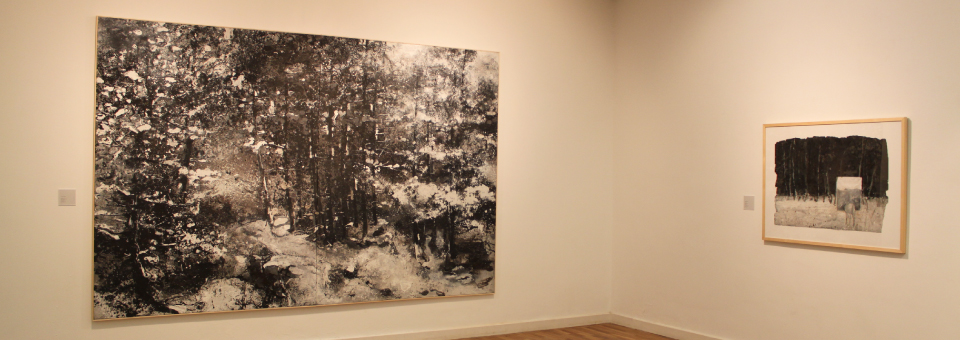Counter-landscape / Riccardo Caldura

During the last four or five years, I have often visited the studio of Orion Shima, located in a newly-constructed building close to the capital’s city center. From a bay window high above, you can set sights on Tirana and notice the building styles dating from various époques. You can also spot the survival of certain dated civic elements, remnants from long ago, before the years of the Communist regime. Here and there, you can also detect rare green spaces from where the tallest trees reach skyward. The city seems to be visibly present, tightly packed with its inhabited density. Back inside the studio, you then turn your eyes to the wall facing away from the window. As in an exhibition, this space has been freed from previous work in order to show the paintings Shima has recently completed first one, than another. Leaving the wall bare is perhaps more than a practical action, similar to the painter turning his back to the window overlooking the city. There is something in Orion Shima’s research related deeply and not coincidentally to the need to create an opening, a free space, by turning to a different direction from the surroundings whose proximity seems to be so overwhelming. Making room, distancing yourself, turning elsewhere.
This representation of nature for Shima has been the act of constantly turning to other possible horizons, rediscovering the landscape as a pictorial theme par excellence.
And it is definitely a rediscovery. Most of the creative life of this Albanian artist – who has been professionally active for the past two decades – was not focused on this theme. Without disputing the centrality of paintings as his favorite medium, there have been other choices present throughout his work. Among those which can be noted are realistic or neo-realistic periods, abstract phases, though not in a materic direction or action painting. In a certain way, we come to the understanding that his painting has never been an uncontrolled gesture, a receptor of those forces that Emilio Vedova would call “quanta energy” that enrich the surface of the canvas, in which the brush is transformed into a seismograph registering deep impulses. And it is exactly the landscape genre that seem conflate hi previous researches, harmonizing a realistic tonality, which Shima preserves, with a kind of informal gesture that enriches the surface of his most recent work. Landscape, after all, can be thought of as a description of the transitory condition of all things – nature in itself being in constant transformation and mutation; an animal stand Pavioni Shqiptar ing against that background of a forest as something epiphanic and evanescent at the same time, like the sudden appearance of a deer in the forest. Such a complex genre as landscape shows a departure of this Albanian artist from tradition, or at least from the typical painting influences of his own country. Instead Shima reconnects to the great European painting tradition which stretches from the romanticism of C.D. Friedrich to Anselm Kiefer, echoing faintly even the latest landscape paintings of Peter Doig. We are not dealing here with obvious references, especially if seen from an Albanian summit. One has to consider what has been the legacy of art in a country at the margins of European context for decades, with deteriorating ties and relations even on a basic cultural level. Albania is still undergoing a deep transformation, standing at the age of the abyss, especially in environmental terms, for the speed with which it is trying to regain lost time, adapting its social and economic model to the increasing international integration.
These are the current conditions that can be glimpsed outside the studio’s window, and it is from such conditions that Shima’s work seems to distance itself, shifting the heart of his research toward a different time and space altogether: that wholly pictorial territory generated between figure and background, between abstract and descriptive sign, calling to mind certain situations and presences that recall the intangible space of dreams, of flatting visions, appearances.
Shima’s research is in constant evolution, always seeking variet formal solutions. Often what appears merely a landscape subject, on closure inspection, appears to be made of paper fragments: a certain collage/painting that generates an international ambiguity between two and three – dimensionality; seemingly nothing more than a building block, is in fact volumetric extension of the same color paper insert. In another work (acrylic on paper, size 70 x 90 cm, 2010, p. 71) a deer in a clearing, emotive often found in Shima’s work, turns away from us, facing towards a distant forest that covers the image’s entire horizon.
Yet there is another detail in this natural scene that reveals an entirely different situation. As with television monitors that enable us to follow two simultaneous actions at the same time, this tableau is constructed as follows: one image shows an immense wooded horizon, while the other juxtaposed scene suggests a path cleared in the forest, a mysterious horizon in the background, opening up in front of the animal who hesitates at which direction to follow.
These shifts, from the seemingly natural order of landscape painting, reflect Shima’s attentiveness to the conceptual aspects of the pictorial image. Especially in his recent paper works, he has put forth a ‘fragmentary’ character that utilizes certain techniques which reminds us not only of collage but also of décollage, the process of unsticking and tearing through successive layers of glued paper. In this way, the classic landscape theme is revisited through an analysis aimed at deconstructing the very composing elements of the image proper.
Riccardo Caldura
